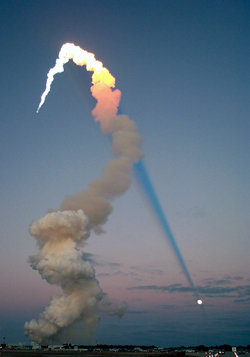The Mystifying Shuttle Shadow By David L. Chandler (From Weatherwise Magazine July/August 2001 Edition, and as published in the Boston Globe Newspaper)

The launch of the space shuttle Atlantis on February 7, on a mission to the International Space Station, was one of the most spectacularly beautiful ever. Lifting off at 20 minutes after sunset and eight hours before a full moon created spectacular visual effects, it was best captured in this photo by Pat McCracken of NASA Headquarters
But many people were mystified by the long, dark cone extending from the Shuttle's bright exhaust plume to the full moon near the horizon. Some news accounts described it as rainbow like, and some observers wondered how a dark shadow could possibly extend from one very bright object (the shuttle plume) to another (the full moon).
Robert Greemler, a leading expert in unusual optical phenomena in the sky, believes the explanation lies in the shadow cast by the rockets own plume whose base was still in darkness in whose tall spire extended up into Sunlight, progressing through the colors of sunset along the way.
The phenomenon is closely related to the dark rays that are often seen extending upward from the Sun around Sunset, called crepuscular rays. These are the shadows of clouds or mountains near the horizon. In some cases, these rays can be seen converging on the opposite side of the sky, where they are called "anticrepuscular rays."
"My guess is that we are looking at an anticrepusucular ray, which in this case is the shadow cast across the sky by the rocket plume." said Greenler, a physicist and author of “Rainbows, Halos and Glories and Chasing the Rainbow”.
"The lower part of the plume is dark and the top is bright, which suggests that the sun had just set for an observer on the ground but still illuminates the plume higher in the sky. A shadow cast by the obscuring plume would be in the form of a fan converging to the antisolar point," the point in the sky exactly opposite the sun's position.
Based on the time of the shuttle launch, Greenler estimated that the antisolar point would be just above the horizon in the east, creating a shadow extending through the moon and disappearing in the murk close to the horizon. The fact that the shadow passes through the moon is just a coincidence, he said, because when full, it is very near the antisolar point.
The confusing fact that the shadow fan converges, instead of diverges, toward the moon is a result of perspective, Greener explained - the same effect that causes parallel train tracks tea appear to converge toward the horizon.
__________________________________
From